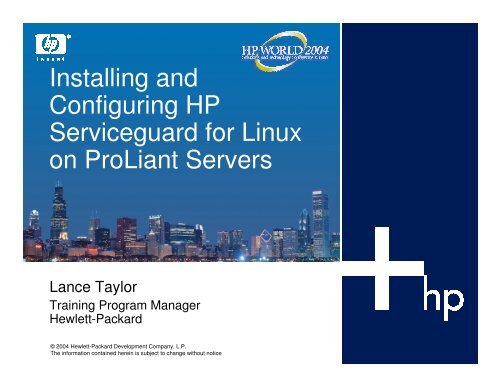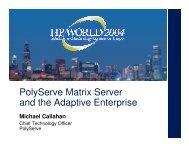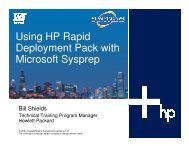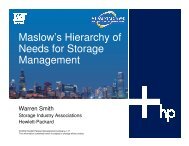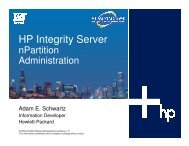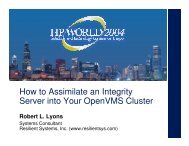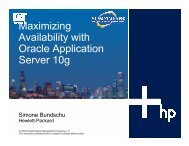Installing and Configuring HP Serviceguard for Linux on ... - OpenMPE
Installing and Configuring HP Serviceguard for Linux on ... - OpenMPE
Installing and Configuring HP Serviceguard for Linux on ... - OpenMPE
You also want an ePaper? Increase the reach of your titles
YUMPU automatically turns print PDFs into web optimized ePapers that Google loves.
<str<strong>on</strong>g>Installing</str<strong>on</strong>g> <str<strong>on</strong>g>and</str<strong>on</strong>g><br />
<str<strong>on</strong>g>C<strong>on</strong>figuring</str<strong>on</strong>g> <str<strong>on</strong>g>HP</str<strong>on</strong>g><br />
<str<strong>on</strong>g>Serviceguard</str<strong>on</strong>g> <str<strong>on</strong>g>for</str<strong>on</strong>g> <str<strong>on</strong>g>Linux</str<strong>on</strong>g><br />
<strong>on</strong> ProLiant Servers<br />
Lance Taylor<br />
Training Program Manager<br />
Hewlett-Packard<br />
© 2004 Hewlett-Packard Development Company, L.P.<br />
The in<str<strong>on</strong>g>for</str<strong>on</strong>g>mati<strong>on</strong> c<strong>on</strong>tained herein is subject to change without notice
Overview<br />
• <str<strong>on</strong>g>Serviceguard</str<strong>on</strong>g> <str<strong>on</strong>g>for</str<strong>on</strong>g> <str<strong>on</strong>g>Linux</str<strong>on</strong>g><br />
− Protects applicati<strong>on</strong>s from hardware <str<strong>on</strong>g>and</str<strong>on</strong>g> software<br />
failures<br />
− Enables you to create high-availability clusters of <str<strong>on</strong>g>HP</str<strong>on</strong>g><br />
ProLiant or Integrity servers<br />
− Automatically transfers package c<strong>on</strong>trol to another<br />
node if there is a failure<br />
− M<strong>on</strong>itors comp<strong>on</strong>ent health<br />
− All resources required by an applicati<strong>on</strong> can be<br />
organized in to applicati<strong>on</strong> packages<br />
2 − 2-3 2
<str<strong>on</strong>g>Serviceguard</str<strong>on</strong>g> <str<strong>on</strong>g>for</str<strong>on</strong>g> <str<strong>on</strong>g>Linux</str<strong>on</strong>g> target<br />
markets<br />
− Target markets <str<strong>on</strong>g>for</str<strong>on</strong>g> <str<strong>on</strong>g>Serviceguard</str<strong>on</strong>g> <str<strong>on</strong>g>for</str<strong>on</strong>g> <str<strong>on</strong>g>Linux</str<strong>on</strong>g><br />
• Existing <str<strong>on</strong>g>Serviceguard</str<strong>on</strong>g> <str<strong>on</strong>g>HP</str<strong>on</strong>g>-UX customers c<strong>on</strong>sidering a <str<strong>on</strong>g>Linux</str<strong>on</strong>g><br />
plat<str<strong>on</strong>g>for</str<strong>on</strong>g>m<br />
• Early adopters of <str<strong>on</strong>g>Linux</str<strong>on</strong>g> looking <str<strong>on</strong>g>for</str<strong>on</strong>g> a high-availability clustering<br />
soluti<strong>on</strong> (such as the telecommunicati<strong>on</strong>s market)<br />
− Target markets <str<strong>on</strong>g>for</str<strong>on</strong>g> high-availability are driven by<br />
• Increasing levels of availability with decreasing budgets<br />
• Increased customer dem<str<strong>on</strong>g>and</str<strong>on</strong>g> <str<strong>on</strong>g>for</str<strong>on</strong>g> fast, easy, <str<strong>on</strong>g>and</str<strong>on</strong>g> c<strong>on</strong>tinuous<br />
access to in<str<strong>on</strong>g>for</str<strong>on</strong>g>mati<strong>on</strong> <str<strong>on</strong>g>and</str<strong>on</strong>g> services<br />
• Growing dependency <strong>on</strong> IT infrastructure <str<strong>on</strong>g>for</str<strong>on</strong>g> business<br />
processes<br />
• Society <str<strong>on</strong>g>and</str<strong>on</strong>g> business movement toward a more dynamic <str<strong>on</strong>g>and</str<strong>on</strong>g><br />
c<strong>on</strong>tinuously <strong>on</strong>line world<br />
• Increased competitive pressures<br />
2 − 36
Features <str<strong>on</strong>g>and</str<strong>on</strong>g> benefits<br />
− Provides disaster protecti<strong>on</strong><br />
through stretch clustering<br />
− Increases overall cluster<br />
availability<br />
− Provides greater protecti<strong>on</strong><br />
than typical cluster<br />
c<strong>on</strong>figurati<strong>on</strong>s<br />
− Ensures data integrity by<br />
eliminating split-brain<br />
syndrome<br />
− Enables you to per<str<strong>on</strong>g>for</str<strong>on</strong>g>m<br />
<strong>on</strong>line rec<strong>on</strong>figurati<strong>on</strong>s<br />
− Eliminates downtime <str<strong>on</strong>g>for</str<strong>on</strong>g><br />
upgrades<br />
− Maintains per<str<strong>on</strong>g>for</str<strong>on</strong>g>mance levels<br />
− Accelerates <str<strong>on</strong>g>Linux</str<strong>on</strong>g><br />
capabilities<br />
− Uses an intuitive, graphical<br />
interface<br />
− Eliminates retraining<br />
− Protects existing storage<br />
investment<br />
− Speeds deployment<br />
− Delivers unsurpassed c<strong>on</strong>trol<br />
of infrastructure <str<strong>on</strong>g>and</str<strong>on</strong>g><br />
business services<br />
2 − 7-8 4
Competitive l<str<strong>on</strong>g>and</str<strong>on</strong>g>scape<br />
• Key <str<strong>on</strong>g>HP</str<strong>on</strong>g> differentiators<br />
− Only vendor to integrate a total high-availability soluti<strong>on</strong><br />
— Hardware, software, <str<strong>on</strong>g>and</str<strong>on</strong>g> support services<br />
− Experience in high-availability — More than 80,000<br />
licenses of <str<strong>on</strong>g>Serviceguard</str<strong>on</strong>g> <str<strong>on</strong>g>for</str<strong>on</strong>g> <str<strong>on</strong>g>HP</str<strong>on</strong>g>-UX sold<br />
− Str<strong>on</strong>g support services — An extensive portfolio<br />
2 − 185
Comp<strong>on</strong>ents<br />
Packages<br />
Applicati<strong>on</strong>s/services/resources<br />
Apps/Services/Resources<br />
Package Manager<br />
<str<strong>on</strong>g>Serviceguard</str<strong>on</strong>g><br />
comp<strong>on</strong>ents<br />
Cluster Manager<br />
Network Manager<br />
Operating<br />
system<br />
<str<strong>on</strong>g>Linux</str<strong>on</strong>g> <str<strong>on</strong>g>Linux</str<strong>on</strong>g> kernel Kernel (with (with LVM) LVM)<br />
2 − 256
<str<strong>on</strong>g>C<strong>on</strong>figuring</str<strong>on</strong>g> LVM<br />
− Use vgscan to create /etc/lvmtab<br />
− Define the physical volumes that will be used<br />
(pvcreate)<br />
− Create the volume groups<br />
(vgcreate)<br />
− Create the logical volumes<br />
(lvcreate)<br />
− Create the filesystems <strong>on</strong> each logical volume<br />
(mke2fs)<br />
− Mount the filesystems<br />
− Activate the volume groups<br />
(vgchange)<br />
2 − 25-267
Cluster Lock<br />
• Tie-breaker that prevents split-brain syndrome<br />
• Implemented through lock LUN or quorum server<br />
• Required <str<strong>on</strong>g>for</str<strong>on</strong>g> two-node clusters, <str<strong>on</strong>g>and</str<strong>on</strong>g><br />
recommended <str<strong>on</strong>g>for</str<strong>on</strong>g> three- <str<strong>on</strong>g>and</str<strong>on</strong>g> four-node clusters<br />
2 − 18-198
Cluster lock LUN<br />
Node 1<br />
Disk array Node 2<br />
<str<strong>on</strong>g>Linux</str<strong>on</strong>g><br />
Pkg 1<br />
SG/LX<br />
<str<strong>on</strong>g>Serviceguard</str<strong>on</strong>g><br />
<str<strong>on</strong>g>for</str<strong>on</strong>g> <str<strong>on</strong>g>Linux</str<strong>on</strong>g><br />
Switch<br />
Switch<br />
− Can be used <str<strong>on</strong>g>for</str<strong>on</strong>g> cluster up to four nodes in size<br />
− When node obtains lock, that area is marked at “taken”<br />
− Cluster c<strong>on</strong>figurati<strong>on</strong> file identifies complete path name of the lock<br />
LUN<br />
2 − 199
Quorum server<br />
Node<br />
1<br />
Node<br />
2<br />
Quorum<br />
server<br />
Hub<br />
B<strong>on</strong>ding can be c<strong>on</strong>figured <strong>on</strong><br />
the quorum server <str<strong>on</strong>g>for</str<strong>on</strong>g> additi<strong>on</strong>al<br />
redundancy, but is not required<br />
− Can be used in clusters of any size<br />
− Chooses the node to c<strong>on</strong>tinue running if communicati<strong>on</strong> fails<br />
− Must run <strong>on</strong> a server that is separate <str<strong>on</strong>g>for</str<strong>on</strong>g>m the cluster <str<strong>on</strong>g>for</str<strong>on</strong>g> which it is<br />
providing quorum services<br />
2 − 20 10
Using sginstall to install<br />
<str<strong>on</strong>g>Serviceguard</str<strong>on</strong>g> <str<strong>on</strong>g>and</str<strong>on</strong>g> customize the<br />
kernel<br />
−<br />
−<br />
Change to the tools directory <str<strong>on</strong>g>and</str<strong>on</strong>g> run the sginstall<br />
script<br />
Sginstall will<br />
1. Load a set of <str<strong>on</strong>g>Linux</str<strong>on</strong>g> kernel source files<br />
2. Load required kernel patch files<br />
3. Load LVM <str<strong>on</strong>g>and</str<strong>on</strong>g> patches<br />
4. Rebuild the <str<strong>on</strong>g>Linux</str<strong>on</strong>g> kernel<br />
5. Install <str<strong>on</strong>g>Serviceguard</str<strong>on</strong>g> .rpm files in the correct directories<br />
• Syntax of sginstall<br />
Sginstall [-v] [-r ] [-o<br />
nokernel I buildkernel]<br />
3 − 11 22
Cluster c<strong>on</strong>figurati<strong>on</strong> steps<br />
− Create ASCII cluster c<strong>on</strong>figurati<strong>on</strong> file<br />
(cmquerycl)<br />
− Modify ASCII cluster c<strong>on</strong>figurati<strong>on</strong> file<br />
− Check ASCII cluster c<strong>on</strong>figurati<strong>on</strong> file <str<strong>on</strong>g>for</str<strong>on</strong>g> errors<br />
(cmcheckc<strong>on</strong>f –C)<br />
− Create <str<strong>on</strong>g>and</str<strong>on</strong>g> distribute binary c<strong>on</strong>figurati<strong>on</strong> file to nodes<br />
(cmapplyc<strong>on</strong>f –C)<br />
− Start the cluster daem<strong>on</strong>s<br />
(cmruncl)<br />
− View the cluster in<str<strong>on</strong>g>for</str<strong>on</strong>g>mati<strong>on</strong><br />
(cmviewcl)<br />
2 − 25-26 12
Daem<strong>on</strong> processes<br />
− Eight daem<strong>on</strong> processes<br />
• /usr/local/cmcluster/bin/cmclc<strong>on</strong>fd (c<strong>on</strong>figurati<strong>on</strong> daem<strong>on</strong>)<br />
• /usr/local/cmcluster/bin/cmcld (cluster daem<strong>on</strong>)<br />
• /usr/local/cmcluster/bin/cmlogd (cluster system log daem<strong>on</strong>)<br />
• /usr/local/cmcluster/bin/cmlocklund (cluster lock LUN daem<strong>on</strong>)<br />
• /usr/local/cmom/bin/cmomd (cluster object manager daem<strong>on</strong>)<br />
• /usr/local/cmcluster/bin/cmsrvassistd (service assistant daem<strong>on</strong>)<br />
• /usr/local/cmcluster/bin/cmresm<strong>on</strong>d (resource m<strong>on</strong>itor daem<strong>on</strong>)<br />
• /usr/local/qs/bin/qs (quorum server daem<strong>on</strong>)<br />
− All daem<strong>on</strong> processes log to the syslog file except<br />
• Quorum server — Logs to the /usr/local/qs/log/qs.log<br />
• Cluster object manager — Logs to /usr/local/cmom/log/<br />
cmomd.log<br />
2 − 25-26 13
Package c<strong>on</strong>cepts (1 of 2)<br />
Node 1 Node 2 Node 3<br />
Pkg A Pkg B Pkg B<br />
Failure in a three-node cluster<br />
• Packages c<strong>on</strong>tain<br />
− Applicati<strong>on</strong>s<br />
− Resources<br />
• Relocatable IP address <str<strong>on</strong>g>for</str<strong>on</strong>g> the applicati<strong>on</strong><br />
• Applicati<strong>on</strong> data<br />
− Next destinati<strong>on</strong><br />
2 − 27 14
Package c<strong>on</strong>cepts (2 of 2)<br />
− Applicati<strong>on</strong>s are wrapped in to packages with all<br />
resources required to run that applicati<strong>on</strong><br />
− Typical resources used by applicati<strong>on</strong>s<br />
• IP addresses<br />
• Volume groups<br />
• Logical volumes<br />
• File systems<br />
• M<strong>on</strong>itored services<br />
− A package does not c<strong>on</strong>tain <strong>on</strong>ly resources<br />
− Several packages might not c<strong>on</strong>tain data if no disk<br />
volume groups are defined<br />
2 − 27-28 15
Package c<strong>on</strong>figurati<strong>on</strong> steps<br />
− Create package c<strong>on</strong>figurati<strong>on</strong> file template<br />
(cmmakepkg –p)<br />
− Modify the package c<strong>on</strong>figurati<strong>on</strong> file<br />
− Create package c<strong>on</strong>trol script template<br />
(cmmakepkg –s)<br />
− Modify the package c<strong>on</strong>trol script<br />
− Manually copy the package c<strong>on</strong>trol script to all nodes<br />
− Check package c<strong>on</strong>figurati<strong>on</strong> file <str<strong>on</strong>g>for</str<strong>on</strong>g> errors<br />
(cmcheckc<strong>on</strong>f –P)<br />
− Create <str<strong>on</strong>g>and</str<strong>on</strong>g> distribute binary c<strong>on</strong>figurati<strong>on</strong> to nodes<br />
(cmapplyc<strong>on</strong>f –P)<br />
− Start the package<br />
(cmrunpkg)<br />
2 − 25-26 16
<str<strong>on</strong>g>Serviceguard</str<strong>on</strong>g> Manager basics<br />
− Operates as a<br />
st<str<strong>on</strong>g>and</str<strong>on</strong>g>-al<strong>on</strong>e<br />
product<br />
− Integrates with<br />
• Service C<strong>on</strong>trol<br />
Manager 3.0<br />
• <str<strong>on</strong>g>HP</str<strong>on</strong>g> OpenView<br />
• Insight Manager<br />
− Follows the clientserver<br />
model<br />
<br />
<br />
<br />
<br />
<br />
#<br />
<br />
<br />
<br />
<br />
<br />
<br />
#<br />
<br />
<br />
<br />
<br />
<br />
<br />
!<br />
<br />
"<br />
14 –<br />
17<br />
2
<str<strong>on</strong>g>Serviceguard</str<strong>on</strong>g> Manager user<br />
interface<br />
Menu bar<br />
Logo<br />
(spins if busy)<br />
Tool bar<br />
Tree<br />
Map title/<br />
descripti<strong>on</strong><br />
Map<br />
Progress bar<br />
Refresh<br />
enabled<br />
Auto-refresh<br />
timer<br />
Status bar<br />
C<strong>on</strong>necti<strong>on</strong> status<br />
14 – 23<br />
18
Map objects <str<strong>on</strong>g>and</str<strong>on</strong>g> badges<br />
Menu<br />
+ <br />
Maps<br />
<br />
$ % <br />
$ % !<br />
& ' (<br />
) % <br />
Tree<br />
) % <br />
) % <br />
* '<br />
14 – 27<br />
19
<str<strong>on</strong>g>Serviceguard</str<strong>on</strong>g> Toolkits<br />
− Toolkits available from software.hp.com<br />
(click the high availability link)<br />
− Free <str<strong>on</strong>g>Linux</str<strong>on</strong>g> toolkits<br />
• Apache<br />
• MySQL<br />
• NFS<br />
• Postgres<br />
• Samba<br />
• Sendmail<br />
− Toolkits <str<strong>on</strong>g>for</str<strong>on</strong>g> sale<br />
• Oracle & Oracle RAC<br />
• SAP<br />
2 − 25-26 20
<str<strong>on</strong>g>Serviceguard</str<strong>on</strong>g> <str<strong>on</strong>g>for</str<strong>on</strong>g><br />
<str<strong>on</strong>g>Linux</str<strong>on</strong>g> installati<strong>on</strong><br />
<str<strong>on</strong>g>and</str<strong>on</strong>g><br />
c<strong>on</strong>figurati<strong>on</strong><br />
Labs
Co-produced by:


